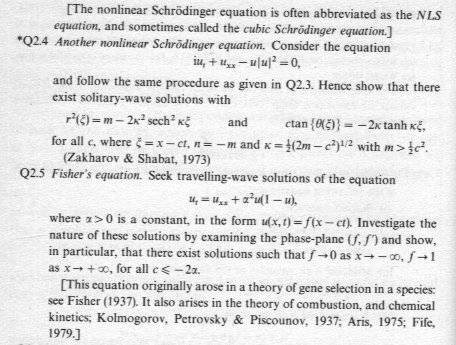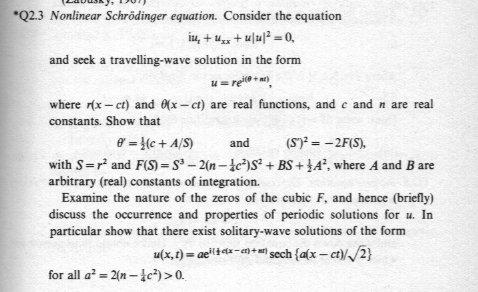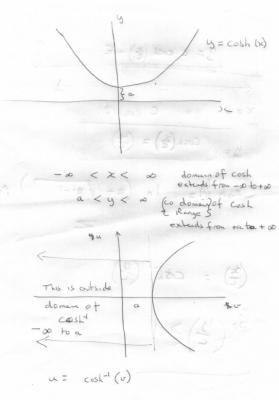-
Posts
18423 -
Joined
-
Last visited
-
Days Won
107
Content Type
Profiles
Forums
Events
Everything posted by studiot
-
You haven't said whether this is in relation to school or college/university. There is a big difference. At school you have to (are supposed to) learn everything about all the subjects. Further the syllabuses are specified in great detail. You are not expected to know things they haven't told you, or work out for yourself the important key points. The key to school success is practice, practice, practice. But take heed of the words of others here about lengths of individual sessions and breaks. At uni you can't learn everything about a much more narrow subject. Not only do you specialise but each college includes or omits different material and their syllabuses are much briefer, more general and more loosely defined. Further they are expecting you to begin to think for yourself so everything is not spelled out in excruciating detail. So it is important to pay particular attention to the material presented and extract the key points. You study should include some fill-in and extension or reading round the subject. Discussion with your peers is always good. Unless you have started taking kryptonite pills you should still take heed of the words of others here about lengths of individual sessions and breaks. Go well in your studies.
-
It is Christmas after all. +1
-
Thanks, imatfaal, it's the internet stuff that's mostly way over my head. If it's possible to b____r it up, netwise, I have found the way. Three further references. Firstly J E Marsden and J R Hughes (Marsden seems to pop up a lot in higher level applied maths) Mathematical Foundations of Elasticity Has a good deal about non linear dynamics and you semi linear Schrondinger equation, in the chapter on functional analysis. Avery Modern book Material Inhomogeneities in Elasticity Gerrard Maugin analysis various NLS equations quite deeply, including numerical emthods. And boasts an extensive modern reference list. Finally also look at Philippe Boulanger and Michael Hayes Bivectors and Waves in Mechanics and Optics.
-
I have just realised that your link allows access to the paper, I do not normally have access to arxiv papers. So I am still trying to understand what exactly you are looing for. Have you looked in Drazin and Johnson Solitons Cambridge University Press? Here are a couple of examples As regards the Hamilton approach, have you looked in Sewell Maximum and Minimum Principles Both these books are from the Cambridge University series in advanced applied maths.
-
Yes that's a correct definiton of linear independence, which is the underlying requirement behinf systems of linear equations. You have a vector of 'basis' variables premultiplied by a matix of coefficients (constants) equaling a vector of results. You need to be able to invert the matrix to solve thsystem. If the matrix is not invertible the system is insoluble and its determinant is zero. The basis functions must be linearly independent, that is one cannot affect the other so not only are cross functions excluded but also linear combinations where x = (say) 3y. Working all this out for yourself is laudible, but doing it the hard way. Try a good book, like the one by Howard Anton Elementary Linear Algebra
-

Bernoulli Principle - blood flow
studiot replied to jsmith613's topic in Anatomy, Physiology and Neuroscience
Interesting, I didn't know that the blood vessels changed diameter appreciably during the pumping cycle. By comparison, canvas hozes do not stretch appreciably even under fire hose pressures. What happens to the surrounding tissue when they expand or contract? -
Are you looking at envelope-soliton or perturbation solutions to the NLS? googling the former even brings up MAtlab code https://www.google.co.uk/search?hl=en-GB&source=hp&biw=&bih=&q=envelope-soliton+solution+of+NLS+equation&gbv=2&oq=envelope-soliton+solution+of+NLS+equation&gs_l=heirloom-hp.3...1281.21203.0.21547.41.16.0.25.2.0.187.2095.0j16.16.0....0...1ac.1.34.heirloom-hp..24.17.2048.vG4e-ILW9QU
-

Bernoulli Principle - blood flow
studiot replied to jsmith613's topic in Anatomy, Physiology and Neuroscience
The best way to look at it mechanically is the statement Fluid tries to flow from high pressure to low pressure. But pressure in Pascals is not a useful measure, since not all processes can be measured in Pascals. Bernoulli offers a way to overcome this by using a term known as 'head' or pressure head. All the processes, standing pressure of the fluid, the kinetic energy of the fluid, the resistance to flow of the pipework, the energy injected by pumps can be expressed in terms of pressure head (measured as a length or distance) and thus compared and accoutned for. I do not think the gravitational variation is significant or even measurable (although it too can be expressed as a head) in human circulatory systems. -

Bernoulli Principle - blood flow
studiot replied to jsmith613's topic in Anatomy, Physiology and Neuroscience
I don't know where you read either of those equations but I would suggest looking for some better books that explain themselves properly. Bernoulli's equation does not apply directly to blood vessels since there is significant resistance to flow (an energy dissipative process) and Bernoulli is a conservation equation. In some instances a modification to Bernoulli is possible where an extra term is introduced to model this dissipative loss. This may be the reason for the negative in your second equation. A second process is also present in blood circulation. The pumping process. Pumps, like resistance, are modelled in Bernoulli by introducing extra terms. The circulation pressure component of Bernoulli is not constant, but varies during the pumping cycle. So it depends what is meant by the 'pressure'. A mean pressure,as a function of the systolic and diastolic pressures is defined. https://en.wikipedia.org/wiki/Blood_pressure -
What happens if you hit a liquid with a hammer?
-
Two posts and we are no clearer what you want to achieve. When you say under impact, what do you mean change colour? Do you mean just during the impact? Does it have to maintain the new colour after imapct? Or should it revert to its old colour after the very short term impact forces have dissipated? Can it be a contraption rather than a material? Why impact? What about sustained pressure? Or what about tension? Soap films go through dramatic colour changes as the tension varies.
-
First off let me point out that most glass surfaces/interfaces with the rest of the world are not sharp they are smooth. For example the surface of a window pane or light bulb. However glass also has significant locked in residual stresses. These make it quite unlike a metal lattice which is basically in equilibrium. The glass structure is more like a taught bow, with significant energy available if the string is released. https://www.google.co.uk/search?hl=en-GB&source=hp&biw=&bih=&q=residual+stresses+in+glass&gbv=2&oq=residual+stresses+in+glass&gs_l=heirloom-hp.3...688.11641.0.11938.26.15.0.9.9.0.265.1718.0j9j2.11.0....0...1ac.1.34.heirloom-hp..11.15.1922.ucBFGoQkFeY Traditional stress relieving techniques like anealing do not work fully with glass. Glass is subject to a particular form of brittle failure known as fast fracture. This is exacerbated by the residual stress energy, which promotes rapid and catastophic crack propagation once initiated, because of the available residual stress energy. The shortest distance between two points in the engineering world is a straight line, so straight cracks with angular (sharp) edges form preferentially over other shapes. http://ocw.mit.edu/courses/materials-science-and-engineering/3-11-mechanics-of-materials-fall-1999/modules/frac.pdf Does this help?
-

Does mathematics really exist in nature or not?
studiot replied to seriously disabled's topic in General Philosophy
Indeed we can agree on that. But I need to finish my supper, would you believe it - a bowl of dead friyut, otherwise known to the English as stewed fruit (and custard). On that note I also think it is time to call time on this thread. -

Does mathematics really exist in nature or not?
studiot replied to seriously disabled's topic in General Philosophy
Hello, kisai, let me introduce the collective noun. In the traffic queue outside my house there are 5 different types of car. So, like the apples they are all different. But they are all vehicles. So there are five vehicles. Likewise there are five fruit in the basket of apples. -
Hello Imatfaal, you might like to know that this thread was duplicated http://www.scienceforums.net/topic/92440-catenary-solution-problem-solving-for-constant-a-in-cosh-formula/
-
Minette doesn't only appear in the sout west UK, it also appears in the south west US. https://books.google.co.uk/books?id=d_mqypQ0YgAC&pg=PA236&lpg=PA236&dq=minette+rock&source=bl&ots=XjhTkm4DCE&sig=8XzgvEGWh9FSPaICK1P73YphnHQ&hl=en&sa=X&ved=0ahUKEwiI-7aX8rfJAhXMOhQKHZm8BYsQ6AEIQTAK#v=onepage&q=minette%20rock&f=false
-

Does mathematics really exist in nature or not?
studiot replied to seriously disabled's topic in General Philosophy
The only thing that is clear here is that you have either not read the original post properly or that you have ignored it. To refresh your memory the question was and still is "Does Mathematics exist in Nature?" If Nature does not exist then nothing it contains can exist and we have no discussion. So for the purposes of having this discussion we need to assume the existence of Nature. For those who think that the original question did not include the possibilty that some part of the whole of Mathematics is manifest in Nature and wish to stick to numbers, why would you expect counting in Nature to be the same as counting by humans? For one thing counting by humans is not always accurate, humans make mistakes. Animate entities already discussed also make mistakes. But inamate Nature can count with 100% accuracy. For example when sodium chloride or calcium chloride dissociate into ions, exactly the right number of electrons is always transferred. Never ever one too many or one to few or 1.3 times the correct number. That fellow fallible humans is counting. -

Catenary solution problem solving for constant 'a' in cosh formula.
studiot replied to Mike_B's topic in Applied Mathematics
I noticed a small error in line 3 of post#4. Perhaps some kind mod would put it right. It should read [math]\sinh (w) = \sqrt {{w^2} - 1} [/math] Of course it should be noted that these equations only apply when the cable is uniformly loaded throughout its length. This is sometimes the case but not for engineering structures such as bridges and cable stayed/supported structures. Telephone wires and some washing lines are heavy enough for their own weight to be sufficient loading, but for lines that approach weightless the curve approaches more and more nearly a parabola. The above is the mathematical approach, a good treatment of the engineering approach to simplify things is given in Pippard "Analysis of Engineering Structures" -

Does mathematics really exist in nature or not?
studiot replied to seriously disabled's topic in General Philosophy
Although I have previously discussed counting and number in this thread I really can't see why members are so obsessed with restricting Mathematics to number. I have, in my library a book entitled The Mathematical Description of Shape and Form. It is a most useful and practical textbook for the subject, which is a part of Mathematics at least as old and important as counting. But here's the rub. There is all this nonsense about order and pattern being spouted, as though there were shapes and forms that were mathematical and those which were not. Mathematics can and does describe any shape whatsoever, as well as regular ones. So the shape of say the earth is well, Earth shaped. That shape is unique but appears in the set of all possible shapes in Mathematics and in the Earth in Nature. I think we can take it as read that we are not debating the existence of the Earth in this discussion. If the very existence of Nature itself was under debate then there would be no point in this thread. -

Catenary solution problem solving for constant 'a' in cosh formula.
studiot replied to Mike_B's topic in Applied Mathematics
Let [math]x = {\cosh ^{ - 1}}\left( w \right)[/math] Then [math]w = \cosh \left( x \right)[/math] So [math]\sinh \left( x \right) = \sqrt {{w^2} - 1} [/math] Therefore [math]{e^x} = w + \sqrt {{w^2} - 1} [/math] Take logs [math]x = \ln \left( {w + \sqrt {{w^2} - 1} } \right) = {\cosh ^{ - 1}}\left( w \right)[/math] as required. The attachment shows the domain of cosh(x) and its inverse The arc length, is geven as a function of the slope, theta and a. [math]s = a\tan \theta [/math] differentiate [math]\frac{{ds}}{{d\theta }} = a{\sec ^2}\theta [/math] also [math]\frac{{dx}}{{ds}} = \cos \theta [/math] So [math]\frac{{dx}}{{d\theta }} = \frac{{dx}}{{ds}} \bullet \frac{{ds}}{{d\theta }}[/math] [math]\frac{{dx}}{{d\theta }} = \cos \theta a{\sec ^2}\theta = a\sec \theta [/math] Integrate [math]x = a\int {\frac{{d\theta }}{{\cos \theta }}} = a\ln \left( {\sec \theta + \tan \theta } \right)[/math] Similarly [math]\frac{{dy}}{{d\theta }} = \sin \theta a{\sec ^2}\theta [/math] Integrate [math]y = a\int {\frac{{\sin \theta d\theta }}{{{{\cos }^2}\theta }}} = a\sec \theta + D[/math] Which gives x and y as functions of the slope. Constants c and D can be made zero by suitable choice of coordinate axes, as with the other solution. -
This thread belongs in speculations, if anywhere.
-

Catenary solution problem solving for constant 'a' in cosh formula.
studiot replied to Mike_B's topic in Applied Mathematics
What are you using your catenaries for? Do you have a derivation for my logarithmic formula and have you seen the alternative secant solution to the catenary? -
Macroscopic is a term that is relative to the wavelength, ie much bigger than the wavelength. The wavelength of a 100Hz soundwave is 3.4metres.
-

Catenary solution problem solving for constant 'a' in cosh formula.
studiot replied to Mike_B's topic in Applied Mathematics
It is not clear how you are solving your equations. However there are restrictions on the domain of the inverse hyperbolic cosine in particular for any w [math]{\cosh ^{ - 1}}\left( w \right) = \ln \left( {w + \sqrt {{w^2} - 1} } \right):w \ge 1[/math] Given these restrictions let us consider your equation [math]y = a\cosh \left( {\frac{x}{a}} \right)[/math] [math]\frac{x}{a} = {\cosh ^{ - 1}}\left( {\frac{y}{a}} \right)[/math] [math]\left( {\frac{y}{a}} \right) \ge 1[/math] [math]y \ge a[/math]




